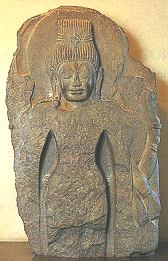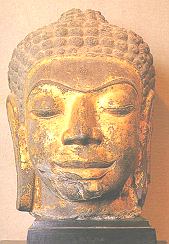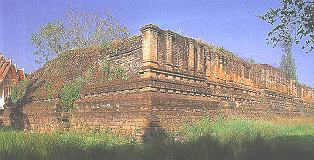|
- There are numerous religious structures of historical significance in Khu Bua Sub-district of Muang District, Ratchaburi. The mystic and enchanting Dvaravati civilisation is reflected in many cities in
Thailand.
- Located on the bank of the Mae Klong River, about five kilometers from town, Khu Bua is belived by some historians to have been a center of state power as was
Nakhon Pathom. Evidence shows that this city was prosperous around 657-857 AD when it was ruled by the monarchy, with the Buddhists
of the time ascribing to both Mahayana and Hinayana Buddhism. The architectural and artistic features of Khu Bua were modelled after those of the Indian Gupta Dynasty, and the city was suitable as a port because of its location near the sea.
- At least eight different types of old pagoda, stupa and vihrn still remain, with the ruins at Wat Khlong Suwannakhiri providing eloquent testimony as to Khu Bua's splendor in the past. Wat Khlong's Dvaravati Pagoda is a large squared-based
structure with distinctive decoration around the base and pillars adjacent to the walls while the curved miniature walls clearly reflect the Indian influence. The pagoda base consists of several tiers intricately decorated,
showing that it must have been created by master-craftsmen of the day. It is believed to be much older than others of the Sukhothai Period (late 13th - 15th centuries).

The Buddha image found at Khubua

Head of Dvaravati Buddha image found at Khubua,
now displayed in Ratchaburi National Museum
- The ruins of other stupas and viharns are to be found scattered throughout the Khu Bua Sub-district, proving that Buddhism firmly flourished in this part of the country. However, time has played its game, and even the
real name of this city is not yet known.
- In fact, when these historical sites were formerly found, stucco decorations were clearly seen in such figures as the Buddha to-be, angel, dancing lady, Buddha image, giant, dwarf, princess and lady inwaiting.
The most prominent one among the Dvaravati art objects is the figure of five female musicians playing an ancient Indian instrument. All these artifacts were excavated in Khu Bua. The posture of each figure notably reflects a mystic expression,
with an enigmatic smile that is now difficult to be made out.

The western side of Wat Khlong's Creat Stupa which is the biggest and most beautiful pagoda of Khubua
- These sculptures are recognized by art historians as masterpieces and are now kept at national museums both in Bangkok and the Muang District of
Ratchaburi. And visitors to Khu Bua should not miss the Ratchaburi National Museum. The traces of the past civilisation that can be seen in the museums
and at Khu Bua are really worth exploring for the serious historian, or the interested amateur.
|
Top
|
|
Return to the main page
|

